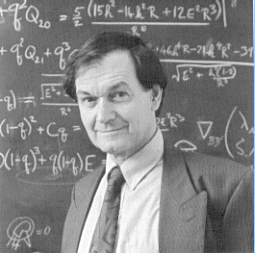Roger Penrose
Roger Penrose, a professor of mathematics at the University of Oxford in England, pursues an active interest in recreational math which he shared with his father. While most of his work pertains to relativity theory and quantum physics, he is fascinated with a field of geometry known as tessellation, the covering of a surface with tiles of prescribed shapes.
Penrose received his PhD at Cambridge in algebraic geometry. While there, he began playing around with what appears to be a somewhat frivolous geometrical puzzle. He wanted to cover a flat surface with tiles so that there were no gaps and no overlaps. There are several shapes that will do the job, regular triangles, rectangles, hexagons, and so forth. Or it can be done with combinations of shapes, resulting in a pattern that repeats regularly. Penrose began to work on the problem of whether a set of shapes could be found which would tile a surface but without generating a repeating pattern (known as quasi-symmetry). It turned out this was a problem that couldn’t be solved computationally. So, armed with only a notebook and pencil, Penrose set about developing sets of tiles that produce ‘quasi-periodic’ patterns; at first glance the pattern seems to repeat regularly, but on closer examination you find it is not quite so.
Eventually Penrose found a solution to the problem but it required many thousands of different shapes. After years of research and careful study, he successfully reduced the number to six and later down to an incredible two.

These tiles are particularly intriguing to play with because you have to take into account more than just the tile next door to decide how pieces fit together.. The puzzle consists of bird-shaped pieces which are kept in play on a gameboard built into the box. Using just the two shapes, small and large birds, the goal is to completely cover the playing surface. Sounds easy? It’s not, and there is only one solution. At higher levels you substitute a rogue dog for a large bird and the solutions change. By the time you have five dogs substituted you’ll have gone through potentially 23 different solutions to just one puzzle.
While this may all sound rather far removed from life in the real world, it turns out that some chemical substances will form crystals in a quasi-periodic manner. Professor Penrose tells of a striking demonstration of the benefits of pure research – a French company has recently found a very practical application for substances that form these quasi-crystals: they make excellent non-scratch coating for frying pans.
Penrose was raised in a family with strong mathematical interests: his mother was a doctor, his father, a medical geneticist, used math in his work as well as his recreation, one brother is a mathematician, another was ten times British chess champion. Roger originally was more attracted to medicine than math, but when forced to choose between biology and math because of inflexible school scheduling, he was not willing to give up the mathematics.
Roger and his father are the creators of the famous Penrose staircase and the impossible triangle known as the tribar. Both of these impossible figures were used in the work of Dutch graphic artist Maurits Cornelis Escher to create structures such as a waterfall where the water appears to flow uphill and a building with an impossible staircase which rises or falls endlessly yet returns to the same level.
In addition to the recent honor of knighthood, Professor Penrose was awarded the prestigious Wolf Prize for Physics in 1988 which he shared with Stephen Hawking.


